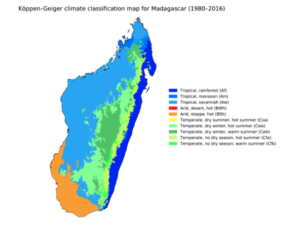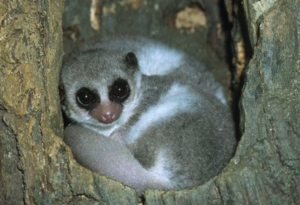Climate and Seasonality in Madagascar
About 200 miles off the coast of Mozambique is one of the world’s top biodiversity hotspots, an island referred to as the 8th continent due its large size and incredible endemic wildlife. Within about 230,000 square miles, the island of Madagascar contains a landscape as diverse as its creatures, boasting mountain ranges, lush rainforests, spiny deserts, and razor-sharp limestone formations. Madagascar is located between 11°57′ and 25°32′ south latitude, which falls almost entirely within the tropical zone. Madagascar’s size, topography, and equatorial location combine to create a mix of habitat types with their own unique climates.

Climate classification map of Madagascar
As an equatorial island, Madagascar has two main seasons rather than four. During the dry season, from May to October, rainfall is very low and temperatures are cool. In the driest regions of Madagascar, average rainfall is only 16 inches per year, and only 3 inches during the dry season months. These dry conditions give rise to a desert ecosystem, where cacti and succulents thrive, and nighttime temperatures can dip into the low 50s Fahrenheit.
November to April sees heavy rainfall and warmer temperatures, bringing about a lush growing season and plentiful food resources for the forest-dwelling wildlife. The east coast of Madagascar receives the most rainfall, as it lies in a rain shadow. As warm, moist winds come off of the Indian Ocean and meet the mountains, they drop precipitation all along the east coast, forming a tropical rainforest. The wettest regions of Madagascar receive 16 inches of rain in March alone, and up to 132 inches of rain per year, and see high temperatures in the 90s.
On average, temperatures in most regions of Madagascar hover between 60-80°F. However, daily weather and temperature patterns can fluctuate between extremes, with cold night temperatures and hot daytime temperatures, sudden downpours, high winds, or periods of extreme drought. People and animals across Madagascar experience highly unpredictable climate conditions year-round.

Madagascar is home to a wide diversity of ecosystems including tropical rain forest, dry desert, savanna, and dry deciduous forest.
In response to these variable climate conditions, Madagascar’s wildlife has adapted to survive in an unpredictable environment. Mammals, reptiles, and amphibians alike employ thermoregulation behaviors to keep their bodies warmer or cooler depending on ambient temperatures. This may look like sheltering or nesting, huddling with others, sunning, decreasing movement, or increasing bodily evaporation by spreading out, licking hands and feet, or panting.
Some species, amphibians in particular, are highly dependent on seasonal conditions for breeding success. Frog species like the golden mantella require certain amounts of rainfall to lay their eggs, so they are seasonal breeders, only coming out to spawn when the rainfall is likely to be highest. Precipitation directly affects resource availability for plant-eating lemurs, so they, too, are seasonal breeders. While lemur species have widely different breeding and birthing seasons, there is a great deal of synchrony in the time at which lemur mothers wean their infants; typically, the time of year at which resources are most plentiful.

Lemurs at the DLC adapt well to the spring, summer, and fall weather of North Carolina.
Many lemur species exhibit an activity pattern called cathemerality, in which they are active for equal amounts during the day and night. Time spent active during the daylight hours tends to increase in the wet season, when food resources are plentiful and competition is low. Nocturnality tends to increase in the dry season, to avoid competition or to avoid being spotted by predators in the leafless trees. We may not associate extreme seasonal activity changes like hibernation with tropical weather patterns, but several species of lemur go into some form of hibernation every year in Madagascar. Torpor and hibernation both allow animals to lower their metabolism in the extreme, and spend the most resource-limited part of the year in a state of low energy output. Dwarf lemurs in Madagascar fully hibernate for up to seven months of the year, during which their metabolic rate and internal body temperature are extremely low. They are able to achieve this long-term torpor by feeding heavily during the wet season on high-calorie foods and storing fat in their tails.

A fat-tailed dwarf lemur snuggles in a tree.
While the wildlife of Madagascar have adapted over millions of years to a highly variable climate, they are now forced to keep up with changing climate conditions as human development disrupts global climate patterns. Extreme weather events like hurricanes, monsoons, and droughts are already impacting Madagascar’s populations, creating unlivable conditions for both wildlife and human citizens of the island. Most of Madagascar’s human populous relies heavily on agriculture to support their health and economy. Increasing weather extremes and unpredictability are causing famine and malnutrition across the country, a phenomenon already prevalent during seasonal periods of low agricultural output. With continually changing global climate conditions, the inhabitants of Madagascar are increasingly in danger. While short-term aid and conservation projects are helping both people and wildlife cope with these struggles, broader climate solutions are needed to continue to protect beautiful, unique places like Madagascar.
Sources:
Bethge, Janina, et al. “Seasonal adaptations in energy budgeting in the primate Lepilemur leucopus.” Journal of Comparative Physiology B 187.5 (2017): 827-834.
Curtis, Deborah J. “Cathemerality in lemurs.” Lemurs (2006): 133-157.
Edmonds, Devin, et al. “Seasonal Activity Patterns of Golden Mantellas (Mantella aurantiaca).” Journal of Herpetology 54.3 (2020): 325-330.
Giroud, Sylvain, et al. “Chronic food shortage and seasonal modulations of daily torpor and locomotor activity in the grey mouse lemur (Microcebus murinus).” American Journal of Physiology-Regulatory, Integrative and Comparative Physiology 294.6 (2008): R1958-R1967.
Ingram, J. Carter, and Terence P. Dawson. “Climate change impacts and vegetation response on the island of Madagascar.” Philosophical Transactions of the Royal Society A: Mathematical, Physical and Engineering Sciences 363.1826 (2005): 55-59.
Sato, Hiroki. “Diurnal resting in brown lemurs in a dry deciduous forest, northwestern Madagascar: implications for seasonal thermoregulation.” Primates 53.3 (2012): 255-263.
Stoner, Kathryn E., and Robert M. Timm. “Seasonally dry tropical forest mammals: adaptations and seasonal patterns.” Seasonally dry tropical forests. Island Press, Washington, DC, 2011. 85-106.
Tattersall, Ian, and Robert W. Sussman. “Notes on topography, climate, and vegetation of Madagascar.” Lemur biology. Springer, Boston, MA, 1975. 13-21.
Tadross, Mark, et al. “Climate change in Madagascar; recent past and future.” Washington, DC: World Bank (2008): 18.
Walls, Susan C., William J. Barichivich, and Mary E. Brown. “Drought, deluge and declines: the impact of precipitation extremes on amphibians in a changing climate.” Biology 2.1 (2013): 399-418.
Wright, Patricia C. “Lemur traits and Madagascar ecology: coping with an island environment.” American journal of physical anthropology 110.S29 (1999): 31-72.

